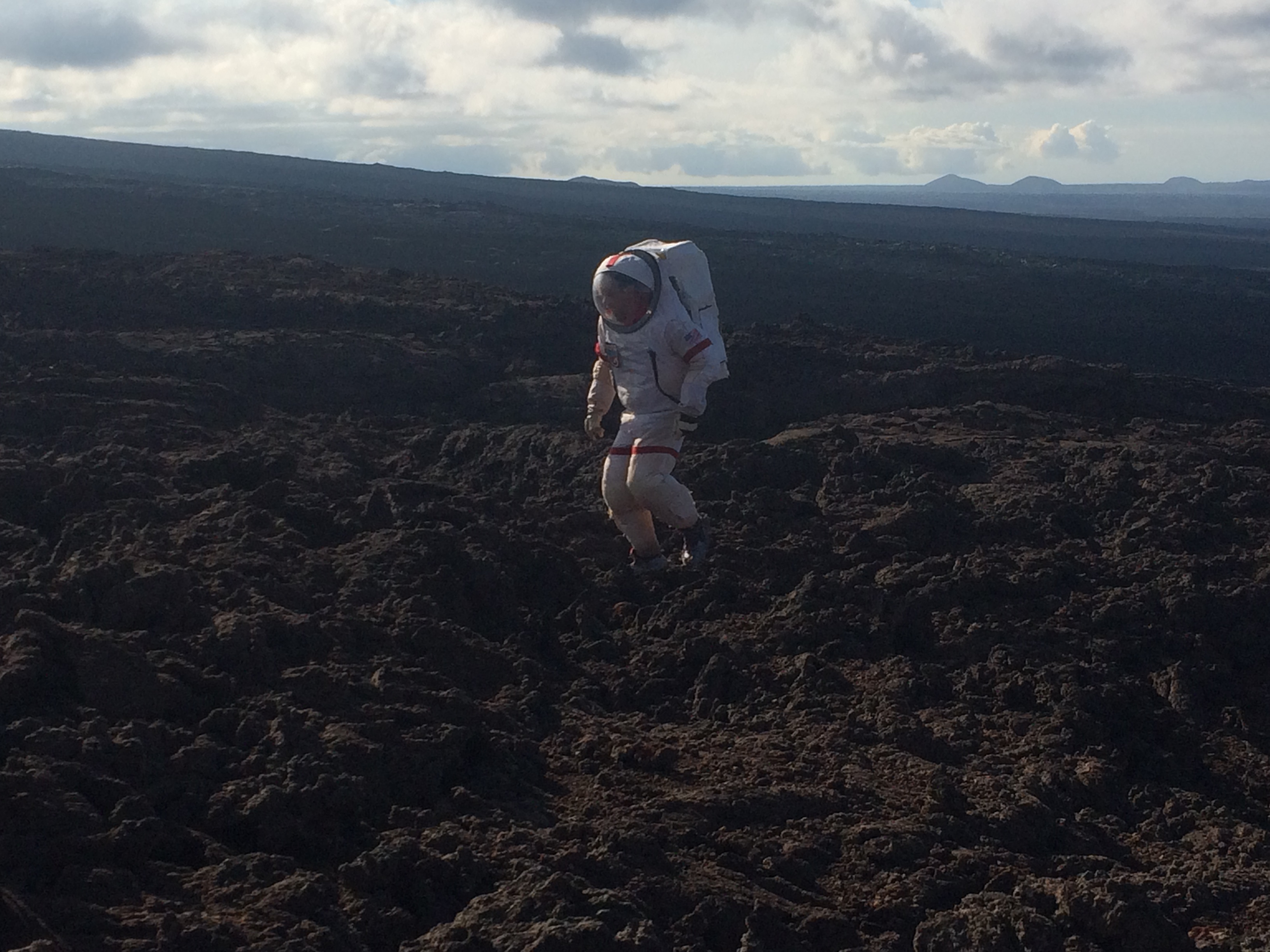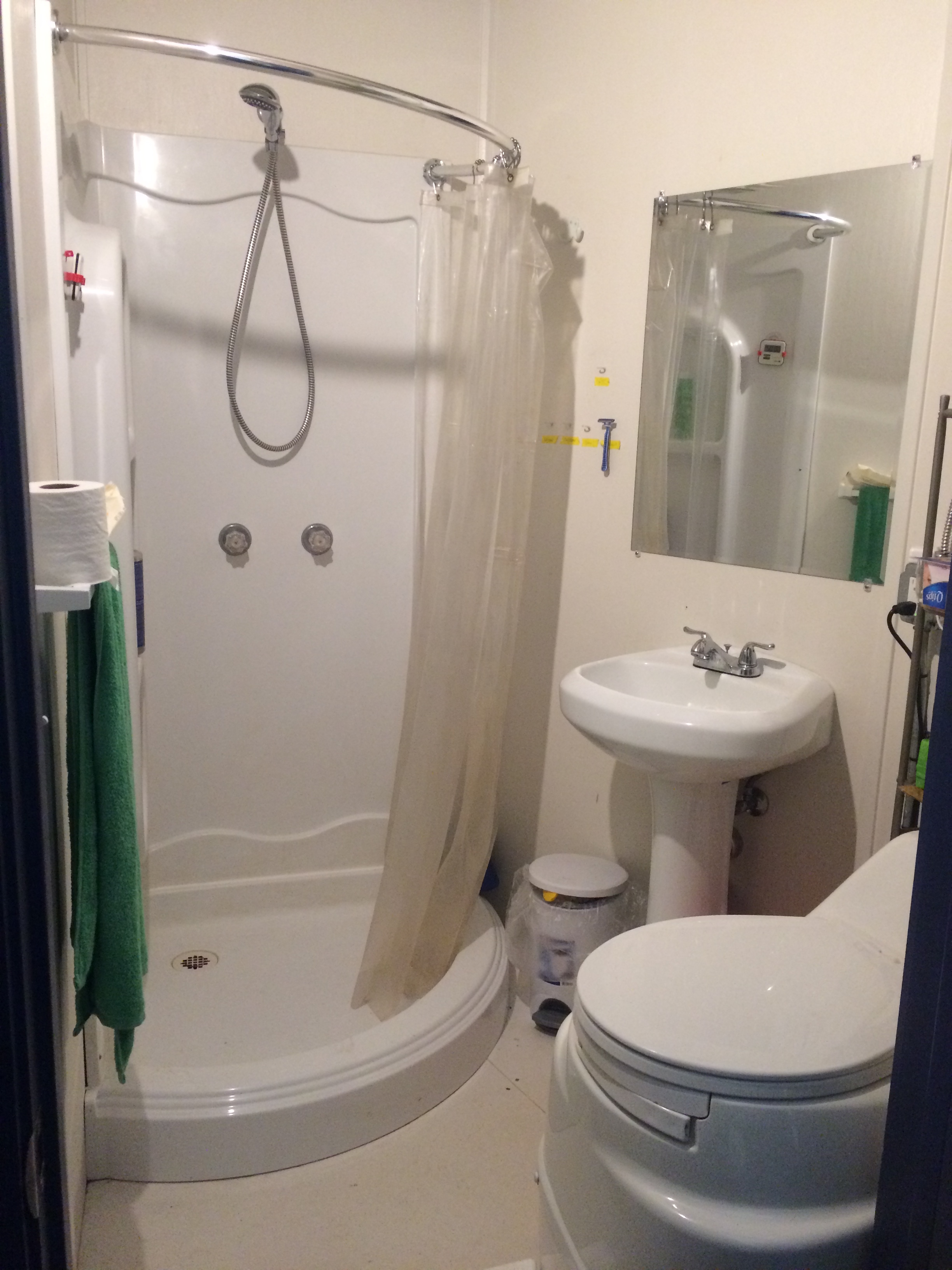We Visited Mock Mars: Here's What It's Like to Live There

MAUNA LOA, Hawaii — What's it like to pretend to live on Mars for a year? A six-person crew recently got a pretty good idea, and Space.com was on-site to see the mock Red Planet habitat firsthand and talk with the mission crewmembers about their experience.
The HI-SEAS program (Hawaii Space Exploration Analog and Simulation) is a NASA-funded mission to study how humans would cope with living on the surface of Mars or another off-Earth location. Program participants, (most of whom possess many of the basic qualifications required for NASA astronaut applicants), stay in a habitat on a barren mountaintop, live on limited resources, have no physical contact with the outside world, and make minimal digital contact with friends and family.
It's a situation most people wouldn't dream of entering voluntarily, and yet the participants in the most recent HI-SEAS mission — who lived in the habitat for a year — said that, while they were happy to go back to their normal lives, they weren't anxious to leave. One participant said he'd miss the habitat, others said they'd willingly return there and all six said they'd go to Mars if they could. [Life on Mars: Inside the HI-SEAS Habitat (Gallery)]
Are these people uniquely fit for this type of task, or are they demonstrating humanity's universal ability to adapt? Is living on Mars really so different from living on Earth?
Space.com toured the HI-SEAS habitat with Carmel Johnston, mission commander; and Christiane Heinicke, chief scientific officer and crew physicist.
Day to day
The HI-SEAS habitat has 1,200 square feet (110 square meters) of floor space — about as much as a decent-size one- or two-bedroom house. The main communal living area on the ground floor has an open-concept style. There is one large, main room — with six desks, a stationary bike and a treadmill — that flows into the kitchen. There are six bedrooms, each large enough for a twin bed, a small piece of furniture and a little room to stand up in. There is one full bathroom and one half bathroom, a storage room and a laboratory. (A second laboratory was set up inside a large shipping container outside the habitat.) There are also two entryways for the habitat's two doors, and during the mission, crewmembers also use these areas for storage or extra work space.
Breaking space news, the latest updates on rocket launches, skywatching events and more!
The dome is large enough to have two full floors, but the designers rejected that idea in favor of giving the living space a high ceiling; it's a nice touch for people who have to spend a lot of time inside. The bedrooms occupy a loft space above the kitchen.
A typical day for the crew is filled up quickly with various responsibilities to keep the habitat functional and clean, as well as tasks associated with the experiments being run by scientists outside the habitat. For the one-year mission, most of those experiments are about maintaining mental well-being, handling stress and finding ways to help the crew get along and deal with conflict. That means filling out a lot of surveys.
The crewmembers also worked on their own science experiments, including growing some plants and vegetables. Cyprien Verseux, the crew biologist, and Heinicke said the mission was a test in scientific resourcefulness — if they ran out of lab supplies, or if things broke or they changed their experiment, they couldn't just pick up new items at the supermarket. While scientists can certainly try to imitate what it might be like, for example, to grow food in a habitat on Mars, the HI-SEAS mission illustrates the kinds of unexpected obstacles that can arise.
Water was limited, and the crewmembers tried to keep their usage to an absolute minimum. Johnston said each person showered once a week for about 60 seconds (or twice per week for 30 seconds) plus had sponge baths as needed. Deodorant and quick-dry exercise clothing (which doesn't hold on to sweat as much as normal clothing does) were also utilized to minimize body odor.
The toilets in the habitat do not use water; instead, they employ electricity to rotate the drum containing the waste and turn it into compost. The bathroom smell was not unbearable, but it probably would be bad enough to stop anyone from spending too much time in there.
The habitat's energy supply comes from solar panels, which can feed the habitat directly, or excess energy can be stored in a set of batteries. Johnston said most days were sunny, and the crew essentially had no restrictions on their usage. But on those low-energy days, the crew would turn off almost everything, including the heat, cooking instruments and treadmill. But "you never turn off the toilet," Johnston said; that would make the smell unbearable.
Exercise was important, so the crewmembers worked out every day, some for as much as 2 hours. There's a treadmill that runs on electricity and a bicycle that generates electricity (though not much, as the crew found out). On low-energy days, they would come up with other forms of exercise, like "running up and down stairs with a backpack full of weights for an hour," Johnston said.
Every night, the crew ate dinner together. All of the food had to be shelf stable, which mostly meant dehydrated (even the meat). A few fresh vegetables were occasionally harvested from the crew's experiments. Each crewmember would cook on a different night; some liked cooking more than others, and some were generally considered better cooks. Breakfast and lunch were typically leftovers. Johnston also baked frequently. The team regularly baked bread in the toaster oven, and tried to have a cake made when it was someone's birthday.
If all of the science, maintenance, cleaning, cooking and side projects weren't enough to keep everyone busy, there was also a digital library of just about every book and movie they could think of, Johnston said. Some of the psychology experiments also involved a virtual-reality universe, and the crewmembers were free to roam around inside there in their free time (although usage varied among crewmembers). They were free to email with friends and family members, but all communication with the outside world came with a 20-minute delay, which made phone calls impossible. Internet access was limited to text only, so no social media.
"You don't want to be bored, but none of us are the type of people to be bored," Johnston said. [5 Crewed Mars Mission Ideas]
Getting to know you
If humans ever travel to Mars, they'll no doubt face an array of technical challenges; but even if everything goes smoothly on that front, there are the interpersonal challenges to worry about.
"There's going to be conflict in these long-duration missions. It just happens," Kim Binsted, project principal investigator for HI-SEAS, told Space.com at the event welcoming the crewmembers back to Earth on Aug. 28. "What you want … is both individuals and teams that are resilient, that are able to come back from conflict and get back to a high-performing level. And that's something that you can both select for and train for."
Johnston said she'd love to return to the habitat with perhaps one other person; because it's cut off from social media and other distractions, it's a place where someone can really get stuff done. But with five other people occupying the same space, it can get a bit distracting, she said.
None of the crewmembers mentioned specific arguments or disagreements, and none named the things their crewmates did that drove them crazy. But as the team members talked about their experience, it was clear that they had things in mind that got on their nerves or that they had to tolerate. For example, some people needed more than a once-weekly shower, some people needed to be reminded to finish tasks, some people liked quiet time and some liked talking.
Binsted said each crew has its own conflicts. For instance, Johnston said her crewmates thought she was the neat freak of the group, even though she'd always considered herself a bit of a slob. Within that particular group of people, she was apparently the cleanest.
As the crew commander, Johnston said she felt an obligation to help keep everyone's spirits high when depression and other negative feelings set in. For her, an essential part of staying mentally healthy was exercising, which she did for 2 hours every day.
"Everybody dealt with it in a different way, and so having somebody else deal with it in a different way than you can often be difficult, especially if you're not understanding why they are doing something the way they are," Johnston said.
One of the few things Johnston and Heinickesaid they wish they could have had was better soundproofing in the habitat.
"You can hear everything," Johnston said. That includes a sneeze from the other side of the habitat and all of the other sounds people make. Each of the six rooms has a vent in the floor that opens into the space below, so no rooms are fully closed off. To feel alone, crewmembers had to put on headphones or earplugs.
"If we want to go to Mars, we'll need better soundproofing," Heinicke said. "I mean, [the designers] told us they basically had the choice of making the rooms more soundproof or giving us, you know, a few extra centimeters of space. And they went with the centimeters of space, and we wish they would have gone with the soundproofing. But, I mean, those are the kinds of things that you learn."
Former NASA astronaut Jay Buckey, now a professor of medicine at the Geisel School of Medicine at Dartmouth College, ran one experiment during the HI-SEAS mission that provided crewmembers with "tools to maintain their behavioral health," he told Space.com. The tools included training in topics such as conflict management and depression treatment.
But the exercises and information he described aren't specific to isolated crews; they're tools that would help any interpersonal relationship, whether on Earth or in space. One could make the case that conflicts among HI-SEAS crewmembers are more intense because they can't just walk way from one another. But people on Earth are often stuck in similar situations; for example, co-workers have to get through the day together, and family members have to live in the same house.
In fact, from what the crewmembers had to say, it seems like the best advice for people going to Mars is also good guidance for people living on Earth.
"Stoicism, as in actually having no emotion, has no place in space at all," said Dr. Sheyna E. Gifford, chief medical safety officer for the mission. "Compartmentalization has a place in space, just as it does in flying planes or being a doctor or anything else. If you have an emotion that's not useful, you put it away; but then you take it out again later. You have to do that. Stoicism has no role.
"Humor is indispensable," she added. "Being a functional person is indefensible. Being a relaxed person is indispensable. Being a happy person is indispensable. No inner peace, no outer space!"
Life goes on
While the six crewmembers were living in their veritable bubble, the world continued on.
Andrzej Stewart, chief engineering officer for the mission, said his stress came mostly from"being disconnectedfrom the rest of the world."
"Things go on at home; I've had, in my family, births and deaths while I've been gone," Stewart said. "And those are things I haven't been able to be around for."
Gifford's grandmother died while the mission was going on (although that was expected, she said). Johnston had wanted to be present when her good friend gave birth, but the baby arrived the day the crew entered the habitat. Then, a favorite coach from high school died suddenly during the first week of the mission.
Heinicke said that, before entering the habitat, the crewmembers sat down and talked about what kinds of things could happen that would make one of them leave the mission before the year was up.
"[We] pretty much agreed that it would have to be something really major — possibly like a family member dying, but not just that — if someone in your family or someone very close actually [needed] help," Heinicke said. "Because if someone in your family dies, they are dead; you cannot do anything for them anymore. … Whereas, let's say, if my mom died and then my dad had asked me, 'I cannot deal with this alone; please come,' that might have been such a situation. But other than that, I think we all agreed, 'We're here. We're on simulated Mars. It has to take a lot to get us away.'"
Of course, this gets at one of the central ways in which HI-SEAS is not entirely Mars-like: If there had been an emergency, the crew members could have left the habitat in a matter of minutes. If one of them needed medical care, they could have gone to a hospital. It's difficult to know just how deeply impacted the HI-SEAS crew, and how it influenced their psychology during the experiment.
"Even though in theory we could leave whenever we wanted, in practice there was so much money involved, so many researchers, counting on us, so much attention from outside that we just could not leave," Verseux told members of the media on Sunday (Aug. 28). "So we really did not have a choice."
There are astronauts who have lived in space for long periods of time (even an entire year) and had to deal with the reality that they cannot simply leave their post. But those astronauts have a lot of responsibilities while they're in space, and may not have time to participate in multiple psychological studies (like the HI-SEAS team did). In addition, astronauts tend to stay in space for six months at a time, and some of their crewmates may leave the station during that time. HI-SEAS provides scientists with an opportunity to study an entire crew of people in-depth.
Is it really so different?
Questions posed to the crewmembers were often tinged with disbelief. After all, weren't these struggles greater than what most people can handle? But, of course, there are many people around the world who live in conditions much worse than those this group endured; there are folks who live in crowded spaces with very little clean water, those unable to see the people they love or those who can't be in nature, among other situations. But every day, people adapt and go on.
What may be most unbelievable, however, is that someone would choose to live this way. So these crewmembers found the thing that motivates them to adapt to a tough situation and get through it. For these six people, living on a mountaintop for a year with a 20-minute communication delay with the outside world is worth it, if their efforts can assist humanity's eventual exploration of other planets.
"For me, coming on this mission, [my thought was that], if I never get to be an astronaut, at least I've done something that's almost like it," Stewart told a group of media representatives. Later, he told Space.com, "I came out here to understand what it's like to be an astronaut — not just the spacesuits, not just the rockets, but the stresses that go along with it, too, getting to understand that and knowing that those are stresses that I could take on."
And when humanity finally makes its way to Mars, "[We will] realize we are woefully ill-equipped in all possible ways, and then we'll make it work," Gifford said. "And it is that process that makes us unique."
HI-SEAS is currently seeking participants for its next isolation mission.
Follow Calla Cofield @callacofield.Follow us @Spacedotcom, Facebook and Google+. Original article on Space.com.

Calla Cofield joined Space.com's crew in October 2014. She enjoys writing about black holes, exploding stars, ripples in space-time, science in comic books, and all the mysteries of the cosmos. Prior to joining Space.com Calla worked as a freelance writer, with her work appearing in APS News, Symmetry magazine, Scientific American, Nature News, Physics World, and others. From 2010 to 2014 she was a producer for The Physics Central Podcast. Previously, Calla worked at the American Museum of Natural History in New York City (hands down the best office building ever) and SLAC National Accelerator Laboratory in California. Calla studied physics at the University of Massachusetts, Amherst and is originally from Sandy, Utah. In 2018, Calla left Space.com to join NASA's Jet Propulsion Laboratory media team where she oversees astronomy, physics, exoplanets and the Cold Atom Lab mission. She has been underground at three of the largest particle accelerators in the world and would really like to know what the heck dark matter is. Contact Calla via: E-Mail – Twitter




